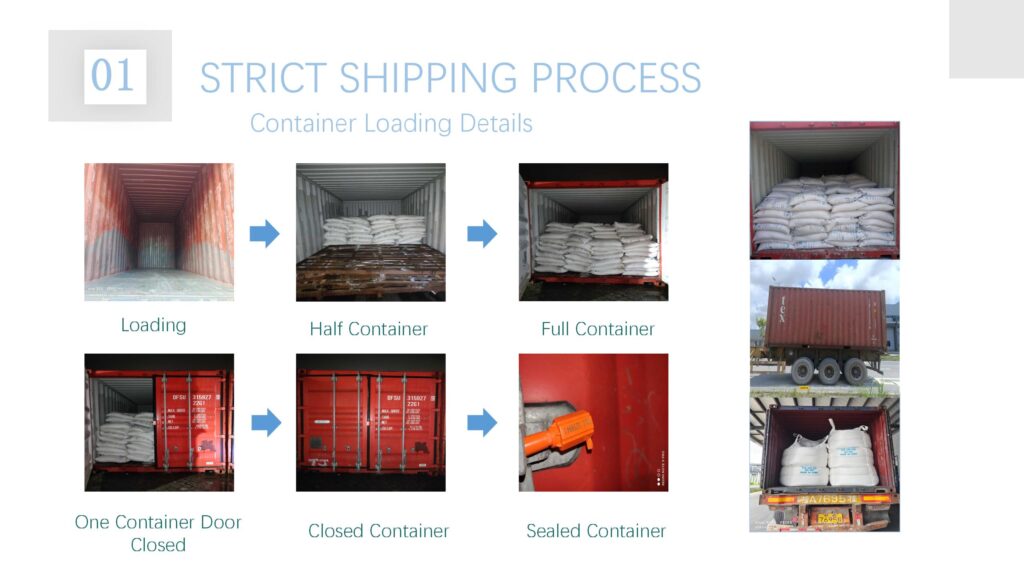In modern industrial production, anhydrous sodium sulfate (Safety Hazards: Dust irritation; avoid inhalation and contact with eyes/skin), as an important chemical raw material, has many uses, such as in detergents (often combined with sodium lauryl sulfate as a surfactant), papermaking, textiles, glass manufacturing.Every step from packaging to transportation to customer delivery may face various challenges. This article provides an in-depth analysis of the entire shipment process for anhydrous sodium sulfate, highlighting common issues and offering practical solutions to help businesses and logistics professionals optimize shipment efficiency.


Overview of the Shipment Process
The shipment process for anhydrous sodium sulfate typically includes the following key steps:
Order Confirmation:
Confirm order details with customers, including quantity, packaging specifications, total price and delivery timelines.
Packaging Preparation:
▪Anhydrous sodium sulfate toxicity (Low toxicity, but prolonged exposure may cause irritation) necessitates proper sealing to minimize dust.
▪Select appropriate packaging forms based on customer requirements, such as 50kg bags or ton bags.
Quality Inspection:
Conduct rigorous quality checks on each batch to ensure that the sodium sulfate content,formula, moisture levels, and other indicators meet the required standards.
Indicator analysis chart
| Item | Unit | Standard |
| Na2CO3 | % | 99.2min |
| Water Insoluble | % | 0.10Max |
| Ca & Mg | % | 0.3Max |
| Fe | % | 0.01Max |
| Moisture | % | 0.2Max |
| Whitness | % | 82% |
| PH Value | % | 6-8 or 9-11 |
Loading and Unloading Operations:
Utilize mechanized equipment for efficient loading and unloading of goods.
Transportation and Distribution:
Deliver goods to the customer’s specified location via road, rail, or sea transport.
Customer Sign-off:
The customer accepts the goods, confirms the delivery, and completes the shipment process.
Packaging Options for Sodium Sulphate Anhydrous
kind of package
Small Bag Packaging:
Typically 50kg woven bags (suitable for sodium lauryl sulfate blends in detergents).
Large Bag Packaging:
1000kg bulk bags (ideal for industrial users)
Illustration:

Containerized Shipping
Container Shipment:
Use 20-foot containers for international shipments, ensuring protection against moisture and contamination. (critical for Glauber’s salt).
Bulk Shipment:
Transported via bulk trucks or containers, ideal for large-scale users to reduce packaging costs. Specialized equipment is required for loading and unloading.
Key Measures to Optimize the Shipment Process
To ensure a smooth and efficient shipment process for anhydrous sodium sulfate, companies can implement the following measures:
Enhance Packaging Management:
Select high-quality packaging materials and refine packaging processes to ensure product safety during transit.
Optimize Transportation Planning:
Choose the most suitable transportation method (road, rail, or sea) based on customer needs and product characteristics. Plan routes in advance to avoid delays.Clarify whether the shipment is anhydrous or Glauber’s salt to avoid application errors.
Improve Customer Service:
Establish robust communication channels to promptly address customer inquiries and improve satisfaction.
Regular Employee Training:
Provide ongoing training for staff involved in packaging, loading, unloading, and transportation to ensure operational standardization and efficiency.
Conclusion
The shipment process for anhydrous sodium sulfate involves multiple critical steps.By optimizing packaging (considering toxicity and hydration state), transportation, loading/unloading, and customer communication processes, businesses can effectively mitigate shipment risks and enhance customer satisfaction.
